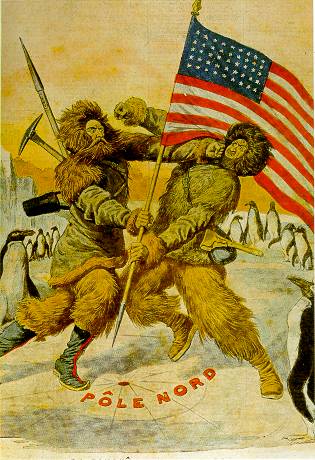The North Pole Debate Still Rages
In September 1909, the American adventurer Frederick A Cook announced that he and two Eskimo companions had just returned from the North Pole after a journey of nearly two years. His bold claims were immediately met with derision by another US veteran of the ice, Robert E Peary. He claimed his own expedition was the first, reaching the Pole on 6 April 1909, conveniently overlooking his Negro manservant, Matthew Henson, who possibly reached it ahead of Peary. More than 100 years later the claims of both these egotistical self-promoters raise serious doubts despite debates supporting both efforts.
Last year, to celebrate the anniversary, British explorer Tom Avery recreated Peary’s trek using replica equipment and dog sleds and actually completed the trek in less time despite a much thinner ice pack.
In truth, any claim about a journey to the North Pole during this era must be doubtful because of the elusive nature of the objective and the inherent inaccuracies of the instruments of the time.
William Mills, the late keeper of collections at the Scott Polar Research Institute (SPRI), author of ‘Exploring Polar Frontiers: A Historical Encyclopedia’ and a regular polar traveller himself, noted:
“Neither Cook’s nor Peary’s claim has been conclusively disproved, and both have their defenders, but informed consensus is against both claims. Commander Richard Byrd’s claim to have made the first aircraft flight to the Pole on 9 May 1926 is similarly controversial and recent evidence suggests that in fact he turned back about 100 miles south of the Pole, though again he too has his defenders. If Cook, Peary, nor Byrd is to be believed, the first to see the Pole were those on Roald Amundsen’s airship Norge on 12 May 1926. However, it was the Soviet’s 1948 aircraft landing that is generally considered to be the closest to the exact geographic goal.”
Despite these other attempts, the most sensational “northing” occurred on 17 August 1977 when the Soviet nuclear icebreaker Arktika became the first surface vessel to reach the Pole.
Today, the Arktika’s sister ship, 50 Let Pobedy (50 Years of Victory), makes annual sorties to the exact location of the geographic North Pole thanks to modern satellite navigation. Unlike Peary, Cook or Henson, expeditioners authenticate their achievement with a certificate and can immediately silence any dinner party detractors.
Reaching the North Pole in 2010
Peregrine Expeditions operates a nuclear-powered icebreaker from Murmansk, Russia to the North Pole. There is one departure this year, on 9-23 July. The vessel carries a maximum of 128 travellers in cabins with facilities and outside views. The cost is US$22,690 per person twin-share, plus airfare from Helsinki to Murmansk at US$1650 per person.
For further information, contact your travel agent or Peregrine Travel Centre, call 1300 854 500, or visit www.peregrineadventures.com.




You must be logged in to post a comment Login